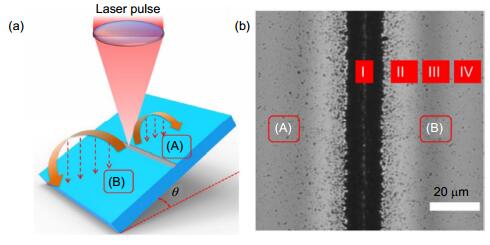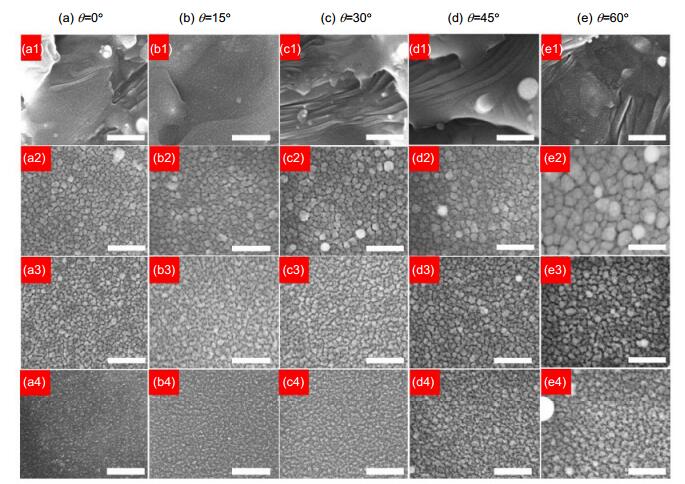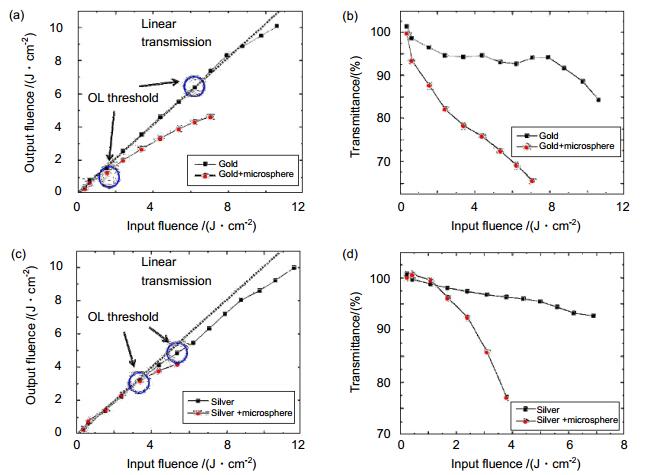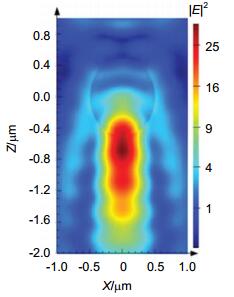Synthesis of nanoparticles by short pulsed laser ablation and its applications in nonlinear optics
-
摘要:
本文主要介绍了纳米颗粒的短脉冲激光制备及其在非线性光学领域的应用。短脉冲激光制备纳米颗粒具有纯度高、操作简单和适用性广等优点,所制备的非线性纳米颗粒尺寸分布均匀,粒度小且可调控,在非线性光学材料中有着独特的地位。为了更深入地对此进行研究,本文介绍了纳米颗粒的光学非线性和激光的特点和原理。在此基础上,通过阐述短脉冲激光与物质相互作用的机理,说明了激光制备纳米颗粒所具有的优点,详细分析了制备条件对合成纳米颗粒的影响,并结合激光制备不同的纳米颗粒,介绍当前激光制备各类纳米颗粒的研究现状。激光制备纳米颗粒是一种操作简便、适用性广,且对环境友好的方法。
Abstract:This paper mainly introduces the fabrication of nanoparticles by short pulsed laser ablation and its applications in the field of non-linear optics. With the characteristics of high purity, simple operation and wide applicability, the non-linear nanoparticles synthesized by short pulsed laser ablation show controllable size and size distribution, which has an unique role in non-linear optical materials. In order to further summarize this research area, this paper first introduces the optical non-linearity of the nanoparticles and the working principles of the pulsed lasers. The mechanism of interaction between pulsed laser and material is described, followed by analyzing the advantages of as-synthesized nanoparticles. The effects of processing parameters are also reviewed in detail. The current research status of various laser ablated nanoparticles is established for preparing different nanoparticles by pulsed laser ablation. Synthesis of nanoparticles by pulsed laser ablation is significantly considered as an environmental-friendly and versatile method.
-
Key words:
- optics /
- pulsed laser /
- nanoparticles /
- nonlinear optics
-

Abstract: This paper mainly introduces the fabrication of nanoparticles by short pulsed laser ablation and its applications in the field of non-linear optics. With the characteristics of high purity, simple operation and wide applicability, the non-linear nanoparticles synthesized by short pulsed laser ablation show controllable size and size distribution, which has an unique role in non-linear optical materials. In order to further summarize this research area, this paper first introduces the optical non-linearity of the nanoparticles and the working principles of the pulsed lasers. Studies on non-linear optics illustrate various new optical phenomenas generated in the process of interaction between intense laser radiation and materials. Non-linear optical effects are derived from nonlinear polarization of molecules and materials. The physical mechanism of generating non-linear polarization mainly includes electron cloud distortion, induced acoustic motion, nuclear movement and optical Kerr effect, which result in anti-saturated absorption, self-focusing and two-photon absorption, and so on. Pulsed laser is produced by stimulated radiation with many advantages including high monochromaticity, high directivity, high strength and high coherence. The mechanism of interaction between pulsed laser and material is described as well, followed by analyzing the advantages of as-synthesized nanoparticles. The laser-materials interaction can lead to complex photo-thermal process, which makes the materials heated up, melt even on gasification, thus producing nanoparticles. So laser ablation has various advantages, such as simple setup, less operating steps, pollution-free process and applicable to most materials. What is more, the as-synthesized nanoparticles have high purity, small particle size and fairly uniform size distribution, and the size can be easily tuned by varying the laser processing parameters. The effects of processing parameters are also reviewed in detail. In general, the fabrication of nanoparticles is mainly affected by the following three factors: pulsed laser parameters (including intensity, pulse length, incidence angle and scanning speed, etc.), the performance of materials (absorption coefficient, chemical properties, melting point and crystallization temperature, etc.) and medium environment (vacuum, air and water, etc.). These parameters can be used to control the performance of nanoparticles. The current research status of various laser ablated nanoparticles is established for preparing different nanoparticles by pulsed laser ablation. The main types of nanoparticles include metal nanoparticles, metal oxide nanoparticles, carbon based nanoparticles and silica based nanoparticles. Researchers have taken these nanoparticles with excellent optical non-linearity highly into account and put the further research plans on the agenda. Synthesis of nanoparticles by pulsed laser ablation is significantly considered as an environmental-friendly and versatile method.
-

-
图 2 (a) 激光液相烧蚀法示意图. (b)激光制备的金和银纳米颗粒. (c),(d)从SEM图像中估计的金(c)和银(d)纳米颗粒的粒径分布[2].
Figure 2. (a) Schematic of the LAL experimental setup. (b) Photograph of laser-generated gold and silver nanoparticle dispersions. (c), (d) size distributions of (c) gold and (d) silver nanoparticles estimated from SEM images[2].
-
[1] Zhou Y, Chen L W, Du Z R, et al. Tunable optical nonlinearity of silicon nanoparticles in solid state organic matrix[J]. Optical Materials Express, 2015, 5(7): 1606-1612. doi: 10.1364/OME.5.001606
[2] Du Zheren, Chen Lianwei, Kao TsungSheng, et al. Improved optical limiting performance of laser-ablation-generated metal nanoparticles due to silica-microsphere-induced local field enhancement[J]. Beilstein Journal of Nanotechnology, 2015, 6: 1199-1204. doi: 10.3762/bjnano.6.122
[3] Muller O, Dengler S, Ritt G, et al. Size and shape effects on the nonlinear optical behavior of silver nanoparticles for power limiters[J]. Applied Optics, 2013, 52(2): 139-149. doi: 10.1364/AO.52.000139
[4] Ahmed M A, El-Katori E E, Gharni Z H. Photocatalytic degradation of methylene blue dye using Fe2O3/TiO2 nanoparticles prepared by sol-gel method[J]. Journal of Alloys and Compounds, 2013, 553: 19-29. doi: 10.1016/j.jallcom.2012.10.038
[5] Eremin A V. Formation of carbon nanoparticles from the gas phase in shock wave pyrolysis processes[J]. Progress in Energy and Combustion Science, 2012, 38(1): 1-40. doi: 10.1016/j.pecs.2011.09.002
[6] Guzman M, Dille J, Godet S. Synthesis and antibacterial activity of silver nanoparticles against gram-positive and gram- negative bacteria[J]. Nanomedicine: Nanotechnology, Biology and Medicine, 2012, 8(1): 37-45. doi: 10.1016/j.nano.2011.05.007
[7] Wu Sihan, Mou Chungyuan, Lin Hongping. Synthesis of mesoporous silica nanoparticles[J]. Chemical Society Reviews, 2013, 42(9): 3862-3875. doi: 10.1039/c3cs35405a
[8] Rhim J W, Wang Longfeng, Lee Y, et al. Preparation and characterization of bio-nanocomposite films of agar and silver nanoparticles: laser ablation method[J]. Carbohydrate Polymers, 2014, 103: 456-465. doi: 10.1016/j.carbpol.2013.12.075
[9] Link S, Burda C, Mohamed M B, et al. Laser photothermal melting and fragmentation of gold nanorods: energy and laser pulse-width dependence[J]. The Journal of Physical Chemistry A, 1999, 103(9): 1165-1170. doi: 10.1021/jp983141k
[10] Gleiter H, Marquardt P. Nanocrystalline structures-an approach to new materials?[J]. Zeitschrift Fuer Metallkunde, 1984, 75(4): 263-267.
[11] Suresh R, Ponnuswamy V, Mariappan R. Effect of annealing temperature on the microstructural, optical and electrical properties of CeO2 nanoparticles by chemical precipitation method[J]. Applied Surface Science, 2013, 273: 457-464. doi: 10.1016/j.apsusc.2013.02.062
[12] Long L Q, Hue T T B, Hoan N X, et al. Growth Mechanism and Stability of Magnetite Nanoparticles Synthesized by the Hydrothermal Method[J]. Journal of Nanoscience and Nanotechnology, 2016, 16(7): 7373-7379. doi: 10.1166/jnn.2016.11110
[13] Wu Junchi, Shi Wenwu, Chopra Nitin. Plasma oxidation kinetics of gold nanoparticles and their encapsulation in graphene shells by chemical vapor deposition growth[J]. The Journal of Physical Chemistry C, 2012, 116(23): 12861-12874. doi: 10.1021/jp301009f
[14] Araújo V D, Avansi W, De Carvalho H B, et al. CeO2 nanoparticles synthesized by a microwave-assisted hydrothermal method: evolution from nanospheres to nanorods[J]. CrystEngComm, 2012, 14(3): 1150-1154. doi: 10.1039/C1CE06188G
[15] Zamiri R, Zakaria A, Ahangar H A, et al. Aqueous starch as a stabilizer in zinc oxide nanoparticle synthesis via laser ablation[J]. Journal of Alloys and Compounds, 2012, 516: 41-48. doi: 10.1016/j.jallcom.2011.11.118
[16] Carneiro J O, Azevedo S, Fernandes F, et al. Synthesis of iron-doped TiO2 nanoparticles by ball-milling process: the influence of process parameters on the structural, optical, magnetic, and photocatalytic properties[J]. Journal of Materials Science, 2014, 49(21): 7476-7488. doi: 10.1007/s10853-014-8453-3
[17] Uda M, Okuyama H, Suzuki T S, et al. Hydrogen generation from water using Mg nanopowder produced by arc plasma method[J]. Science and Technology of Advanced Materials, 2016, 13(2): 025009. https://www.researchgate.net/profile/Yoshio_Sakka/publication/254501280_Hydrogen_generation_from_water_using_Mg_nanopowder_produced_by_arc_plasma_method/links/0deec52a8c5d0d0722000000.pdf?inViewer=0&pdfJsDownload=0&origin=publication_detail
[18] Fujimoto T, Ogawa S, Kanai T, et al. Hydrogen storage property of materials composed of Mg nanoparticles and Ni nanoparticles fabricated by gas evaporation method[J]. International Journal of Hydrogen Energy, 2015, 40(35): 11890-11894. doi: 10.1016/j.ijhydene.2015.05.031
[19] Akbari M K, Derakhshan R, Mirzaee O. A case study in vapor phase synthesis of Mg-Al alloy nanoparticles by plasma arc evaporation technique[J]. Chemical Engineering Journal, 2015, 259: 918-926. doi: 10.1016/j.cej.2014.08.053
[20] Wagener P, Ibrahimkutty S, Menzel A, et al. Dynamics of silver nanoparticle formation and agglomeration inside the cavitation bubble after pulsed laser ablation in liquid[J]. Physical Chemistry Chemical Physics, 2013, 15(9): 3068-3074. doi: 10.1039/C2CP42592K
[21] Li Lin, Hong Minghui, Schmidt M, et al. Laser nano-manufacturing-state of the art and challenges[J]. CIRP Annals-Manufacturing Technology, 2011, 60(2): 735-755. doi: 10.1016/j.cirp.2011.05.005
[22] Procházka M, Mojzeš P, Štĕpánek J, et al. Probing applications of laser-ablated Ag colloids in SERS spectroscopy: improvement of ablation procedure and SERS spectral testing[J]. Analytical Chemistry, 1997, 69(24): 5103-5108. doi: 10.1021/ac970683+
[23] Bae C H, Nam S H, Park S M. Formation of silver nanoparticles by laser ablation of a silver target in NaCl solution[J]. Applied Surface Science, 2002, 197-198: 628-634. doi: 10.1016/S0169-4332(02)00430-0
[24] Chen G X, Hong M H, Tan L S, et al. Optical limiting phenomena of carbon nanoparticles prepared by laser ablation in liquids[J]. Journal of Physics: Conference Series, 2007, 59(1): 289-292. http://adsabs.harvard.edu/abs/2007JPhCS..59..289C
[25] Henglein A. Physicochemical properties of small metal particles in solution: "microelectrode" reactions, chemisorption, composite metal particles, and the atom-to-metal transition[J]. The Journal of Physical Chemistry, 1993, 97(21): 5457-5471. doi: 10.1021/j100123a004
[26] Fojtik A, Henglein A. Laser ablation of films and suspended particles in a solvent: formation of cluster and colloid solutions[J]. Berichte der Bunsen-Gesellschaft, Physical Chemistry, Chemical Physics, 1993, 97(2): 252-254. http://www.mendeley.com/catalog/laser-ablation-films-suspended-particles-solvent-formation-cluster-colloid-solutions/
[27] Tsuji T, Iryo K, Watanabe N, et al. Preparation of silver nanoparticles by laser ablation in solution: influence of laser wavelength on particle size[J]. Applied Surface Science, 2002, 202(1-2): 80-85. doi: 10.1016/S0169-4332(02)00936-4
[28] Tsuji T, Iryo K, Ohta H, et al. Preparation of metal colloids by a laser ablation technique in solution: Influence of laser wavelength on the efficiencies of colloid formation[J]. Japanese Journal of Applied Physics, 2000, 39(10A): L981-L983. https://www.sciencedirect.com/science/article/pii/S1010603001005834
[29] Tsuji T, Iryo K, Nishimura Y, et al. Preparation of metal colloids by a laser ablation technique in solution: influence of laser wavelength on the ablation efficiency(Ⅱ)[J]. Journal of Photochemistry and Photobiology A: Chemistry, 2001, 145(3): 201-207. doi: 10.1016/S1010-6030(01)00583-4
[30] Barcikowski S, Hahn A, Kabashin A V, et al. Properties of nanoparticles generated during femtosecond laser machining in air and water[J]. Applied Physics A, 2007, 87(1): 47-55. doi: 10.1007/s00339-006-3852-1
[31] Sajti C L, Sattari R, Chichkov B N, et al. Gram scale synthesis of pure ceramic nanoparticles by laser ablation in liquid[J]. The Journal of Physical Chemistry C, 2010, 114(6): 2421-2427. doi: 10.1021/jp906960g
[32] Khan S Z, Yuan Yudie, Abdolvand A, et al. Generation and characterization of NiO nanoparticles by continuous wave fiber laser ablation in liquid[J]. Journal of Nanoparticle Research, 2009, 11(6): 1421-1427. doi: 10.1007/s11051-008-9530-9
[33] Khan S Z, Liu Z, Li L. Characteristics of γ-Al2O3 nanoparticles generated by continuous-wave laser ablation in liquid[J]. Applied Physics A, 2010, 101(4): 781-787. doi: 10.1007/s00339-010-5936-1
[34] Abdolvand A, Khan S Z, Yuan Y, et al. Generation of titanium-oxide nanoparticles in liquid using a high-power, high- brightness continuous-wave fiber laser[J]. Applied Physics A, 2008, 91(3): 365-368. doi: 10.1007/s00339-008-4448-8
[35] Hahn A, Barcikowski S, Chichkov B N. Influences on nanoparticle production during pulsed laser ablation[J]. Journal of Laser Micro/Nanoengineering, 2008, 3(2): 73-77. https://www.researchgate.net/publication/224935683_Influences_on_Nanoparticle_Production_during_Pulsed_Laser_Ablation
[36] Liu C H, Hong M H, Zhou Y, et al. Synthesis and characterization of Ag deposited TiO2 particles by laser ablation in water[J]. Physica Scripta, 2007, 129: 326-328. http://iopscience.iop.org/1402-4896/2007/T129/072?v_morerecommendations=yes
[37] Link S, Burda C, Nikoobakht B, et al. Laser-induced shape changes of colloidal gold nanorods using femtosecond and nanosecond laser pulses[J]. The Journal of Physical Chemistry B, 2000, 104(26): 6152-6163. doi: 10.1021/jp000679t
[38] Zhang Hongwei, Peng Xing, Sun Lin, et al. CdSe nanoparticles with clean surfaces: gas phase synthesis and optical properties[C]. 2015 3rd Asia Conference on Mechanical and Materials Engineering, 2015, 26: 01006.
http://www.researchgate.net/publication/283238396_CdSe_Nanoparticles_with_Clean_Surfaces_Gas_Phase_Synthesis_and_Optical_Properties [39] Noël S, Hermann J, Itina T. Investigation of nanoparticle generation during femtosecond laser ablation of metals[J]. Applied Surface Science, 2007, 253(15): 6310-6315. doi: 10.1016/j.apsusc.2007.01.081
[40] Noël S, Hermann J. Influence of irradiation conditions on plume expansion induced by femtosecond laser ablation of gold and copper[J]. Proceedings of SPIE, 2007, 6785: 67850F. https://www.spiedigitallibrary.org/conference-proceedings-of-spie/6785/1/Influence-of-irradiation-conditions-on-plume-expansion-induced-by-femtosecond/10.1117/12.755971.full
[41] Amoruso S, Bruzzese R, Spinelli N, et al. Generation of silicon nanoparticles via femtosecond laser ablation in vacuum[J]. Applied Physics Letters, 2004, 84(22): 4502-4504. doi: 10.1063/1.1757014
[42] Lam H M, Hong M H, Yuan S, et al. Growth of β-Ga2O3 nanoparticles by pulsed laser ablation technique[J]. Applied Physics A, 2004, 79(8): 2099-2102. doi: 10.1007/s00339-004-2893-6
[43] Scaramuzza S, Agnoli S, Amendola V. Metastable alloy nanoparticles, metal-oxide nanocrescents and nanoshells generated by laser ablation in liquid solution: influence of the chemical environment on structure and composition[J]. Physical Chemistry Chemical Physics, 2015, 17(42): 28076-28087. doi: 10.1039/C5CP00279F
[44] Semaltianos N G. Nanoparticles by Laser Ablation of Bulk Target Materials in Liquids[M]//Aliofkhazraei M, ed. Handbook of Nanoparticles. Switzerland: Springer International Publishing, 2016: 67-92.
[45] Zhao Chongjun, Qu Shiliang, Qiu Jianrong, et al. Photoinduced formation of colloidal Au by a near-infrared femtosecond laser [J]. Journal of Materials Research, 2003, 18(7): 1710-1714. doi: 10.1557/JMR.2003.0235
[46] Zhao Chongjun, Qu Shiliang, Qiu Jianrong, et al. Preparation of colloidal Au by a femtosecond laser[J]. Chemistry Letters, 2003, 32(7): 602-603. doi: 10.1246/cl.2003.602
[47] Kabashin A V, Meunier M, Kingston C, et al. Fabrication and characterization of gold nanoparticles by femtosecond laser ablation in an aqueous solution of cyclodextrins[J]. The Journal of Physical Chemistry B, 2003, 107(19): 4527-4531. doi: 10.1021/jp034345q
[48] Chen Lianwei, Jiang Xiaofang, Guo Ziming, et al. Tuning optical nonlinearity of laser-ablation-synthesized silicon nanoparticles via doping concentration[J]. Journal of Nanomaterials, 2014, 2014: 652829. https://www.researchgate.net/profile/Tsung_Sheng_Kao/publication/270627595_Tuning_Optical_Nonlinearity_of_Laser-Ablation-Synthesized_Silicon_Nanoparticles_via_Doping_Concentration/links/565658dc08aeafc2aabf2412.pdf?origin=publication_list
[49] Chen G X, Hong M H, Ong T S, et al. Carbon nanoparticles based nonlinear optical liquid[J]. Carbon, 2004, 42(12-13): 2735-2737. doi: 10.1016/j.carbon.2004.05.035
[50] Xu Kaichen, Zhang Chentao, Zhou Rui, et al. Hybrid micro/nano-structure formation by angular laser texturing of Si surface for surface enhanced Raman scattering[J]. Optics Express, 2016, 24(10): 10352-10358. doi: 10.1364/OE.24.010352
[51] Zeng Huidan, Zhao Chongjun, Qiu Jianrong, et al. Preparation and optical properties of silver nanoparticles induced by a femtosecond laser irradiation[J]. Journal of Crystal Growth, 2007, 300(2): 519-522. doi: 10.1016/j.jcrysgro.2006.11.308
[52] Fan Guanghua, Qu Shiliang, Wang Qiang, et al. Pd nanoparticles formation by femtosecond laser irradiation and the nonlinear optical properties at 532 nm using nanosecond laser pulses[J]. Journal of Applied Physics, 2011, 109(2): 023102. doi: 10.1063/1.3533738
[53] Wang Fei, Yu Hong, Wang Xincai, et al. Maskless fabrication of large scale Si nanohole array via laser annealed metal nanoparticles catalytic etching for photovoltaic application[J]. Journal of Applied Physics, 2010, 108(2): 024301. doi: 10.1063/1.3462397
[54] Ganeev R A, Baba M, Ryasnyansky A I, et al. Characterization of optical and nonlinear optical properties of silver nanoparticles prepared by laser ablation in various liquids[J]. Optics Communications, 2004, 240(4-6): 437-448. doi: 10.1016/j.optcom.2004.06.049
[55] Gao Yachen, Chang Qing, Ye Hongan, et al. Size effect of optical limiting in gold nanoparticles[J]. Chemical Physics, 2007, 336(2-3): 99-102. doi: 10.1016/j.chemphys.2007.05.011
[56] Novak J P, Brousseau L C, Vance F W, et al. Nonlinear optical properties of molecularly bridged gold nanoparticle arrays[J]. Journal of the American Chemical Society, 2000, 122(48): 12029-12030. doi: 10.1021/ja003129h
[57] Danckwerts M, Novotny L. Optical frequency mixing at coupled gold nanoparticles[J]. Physical Review Letters, 2007, 98(2): 026104. doi: 10.1103/PhysRevLett.98.026104
[58] Zhou Q F, Zhang Q Q, Zhang J X, et al. Preparation and optical properties of TiO2 nanocrystalline particles dispersed in SiO2 nano-composites[J]. Materials Letters, 1997, 31(1-2): 39-42. doi: 10.1016/S0167-577X(96)00241-8
[59] Wang Shixing, Wang Mingtai, Lei Yong, et al. "Anchor effect" in poly(styrene maleic anhydride)/TiO2 nanocomposites[J]. Journal of Materials Science Letters, 1999, 18(24): 2009-2012. doi: 10.1023/A:1006646219253
[60] Elim H I, Ji W, Yuwono A H, et al. Ultrafast optical nonlinearity in PMMA-TiO2 nanocomposites[J]. Applied Physics Letters, 2003, 82(16): 2691-2693. doi: 10.1063/1.1568544
[61] Litty I, Nampoori V P N, Radhakrishnan P, et al. Size-dependent enhancement of nonlinear optical properties in nanocolloids of ZnO[J]. Journal of Applied Physics, 2008, 103(3): 033105. doi: 10.1063/1.2838178
[62] Zhang X J, Ji W, Tang S H. Determination of optical nonlinearities and carrier lifetime in ZnO[J]. Journal of the Optical Society of America B-Optical Physics, 1997, 14(8): 1951-1955. doi: 10.1364/JOSAB.14.001951
[63] Chen G X, Hong M H. Time-resolved analysis of nonlinear optical limiting for laser synthesized carbon nanoparticles[J]. Applied Physics A, 2010, 101(3): 467-470. doi: 10.1007/s00339-010-5890-y
[64] Chen G X, Hong M H, Chong T C, et al. Preparation of carbon nanoparticles with strong optical limiting properties by laser ablation in water[J]. Journal of Applied Physics, 2004, 95(3): 1455-1459. doi: 10.1063/1.1637933
[65] Hollins R C. Materials for optical limiters[J]. Current Opinion in Solid State and Materials Science, 1999, 4(2): 189-196. doi: 10.1016/S1359-0286(99)00009-1
[66] Qian Jun, Wang Dan, Cai Fuhong, et al. Observation of multiphoton-induced fluorescence from graphene oxide nanoparticles and applications in in vivo functional bioimaging[J]. Angewandte Chemie International Edition, 2012, 51(42): 10570-10575. doi: 10.1002/anie.201206107
[67] Li Jingliang, Bao Hongchun, Hou Xueliang, et al. Graphene oxide nanoparticles as a nonbleaching optical probe for two-photon luminescence imaging and cell therapy[J]. Angewandte Chemie International Edition, 2012, 51(8): 1830-1834. doi: 10.1002/anie.v51.8
[68] Prusty Sudakshina, Mavi H S, Shukla A K. Optical nonlinearity in silicon nanoparticles: Effect of size and probing intensity[J]. Physical Review B, 2005, 71(11): 113313. doi: 10.1103/PhysRevB.71.113313
[69] Chen Lianwei, Zheng Xiaorui, Du Zheren, et al. A frozen matrix hybrid optical nonlinear system enhanced by a particle lens[J]. Nanoscale, 2015, 7(36), 14982-14988. doi: 10.1039/C5NR03304G
[70] Jin Y J, Chen L W, Wu M X, et al. Enhanced saturable absorption of graphene oxide film via photonic nanojets[J]. Optical Materials Express, 2016, 6(4): 1114-1121. doi: 10.1364/OME.6.001114
-


 E-mail Alert
E-mail Alert RSS
RSS

 下载:
下载:










